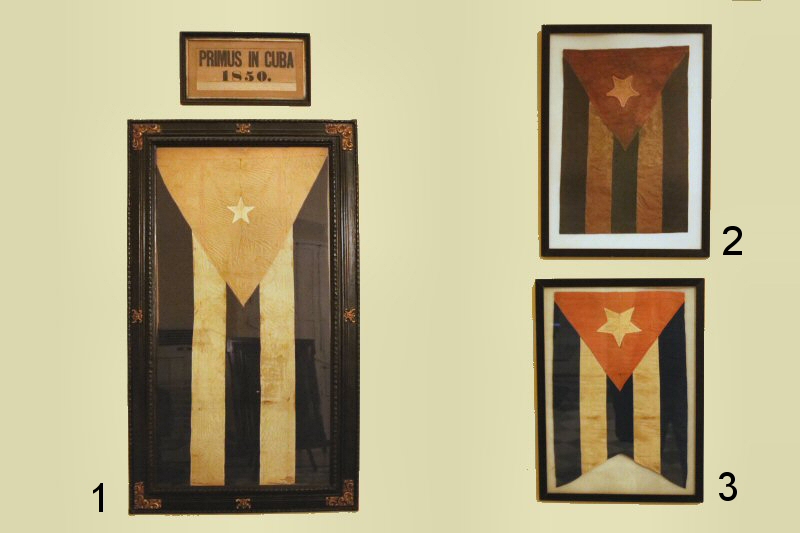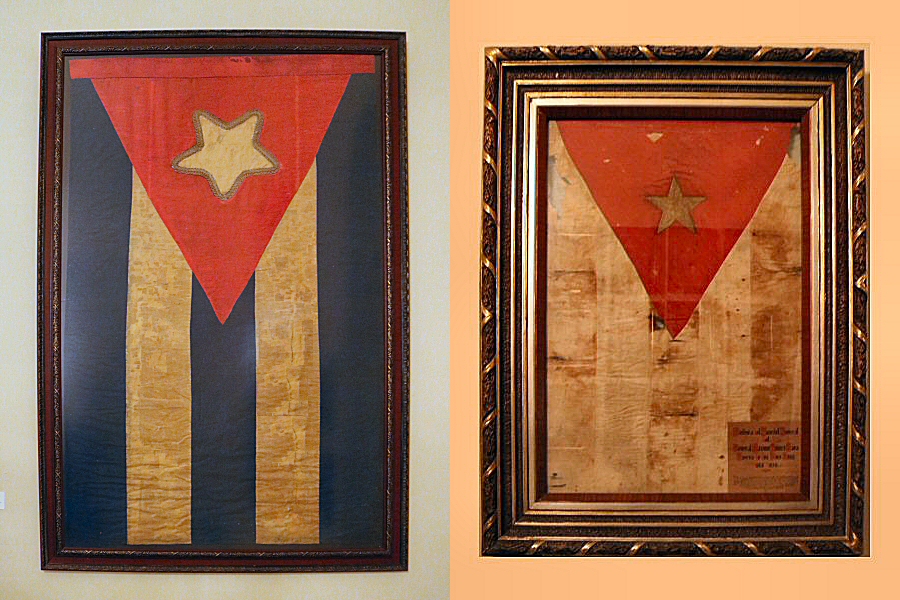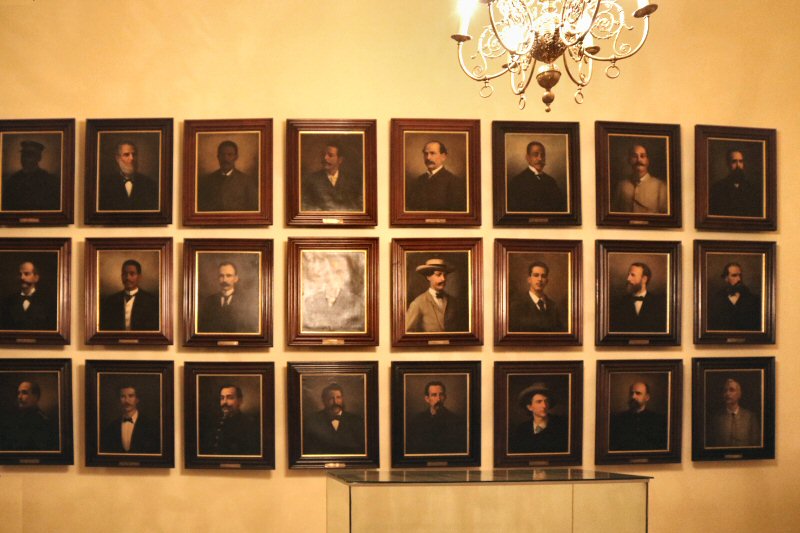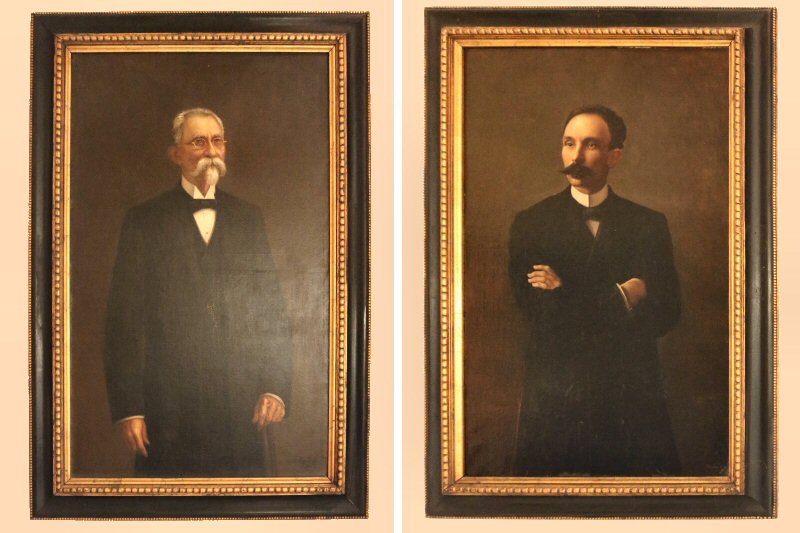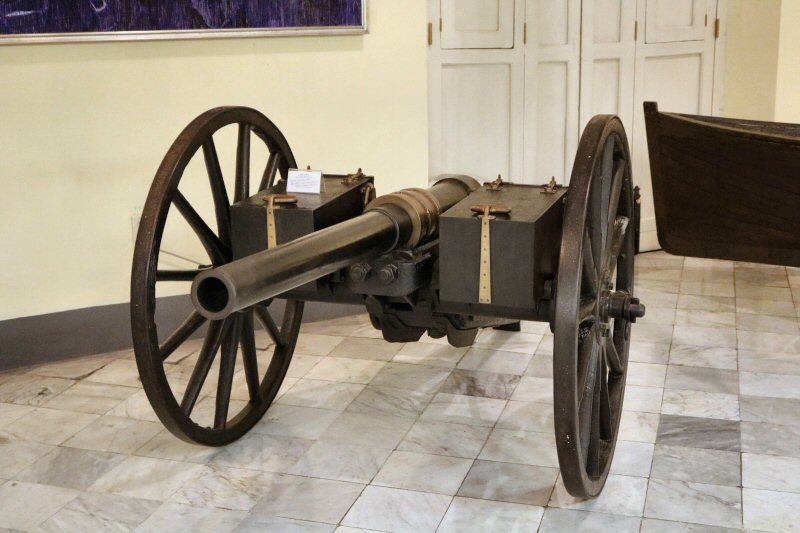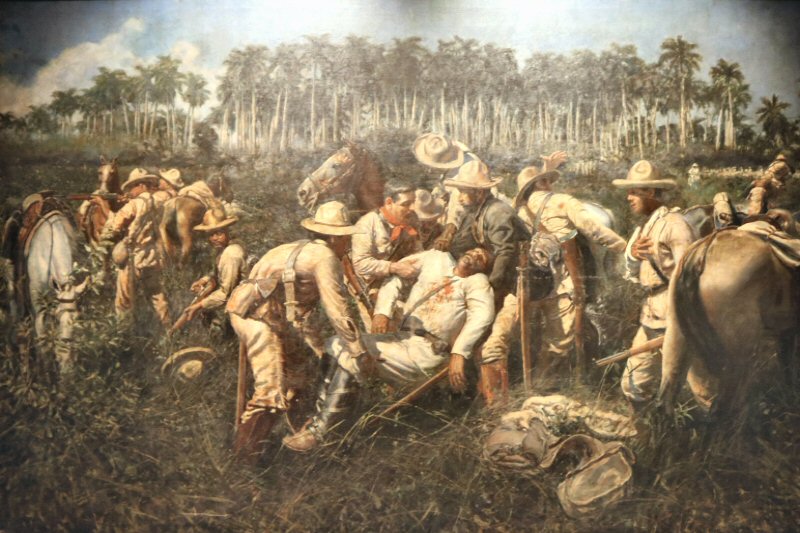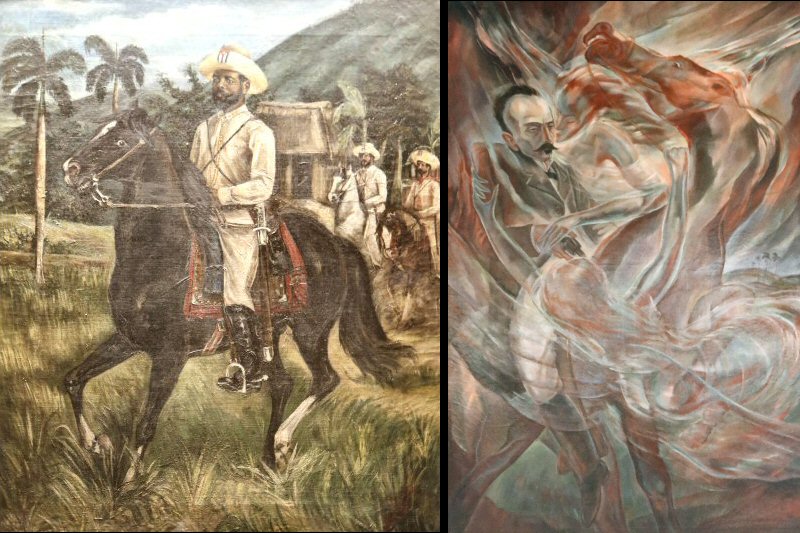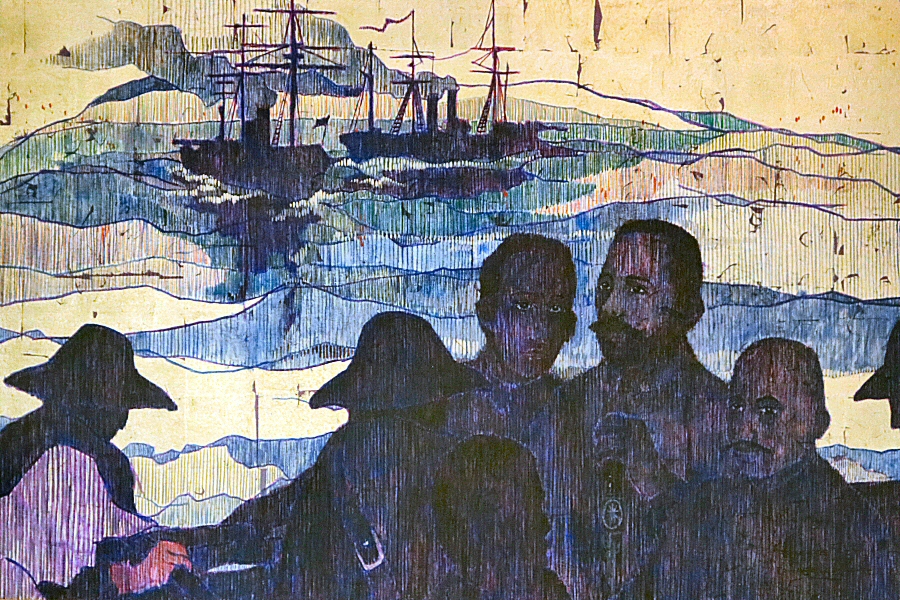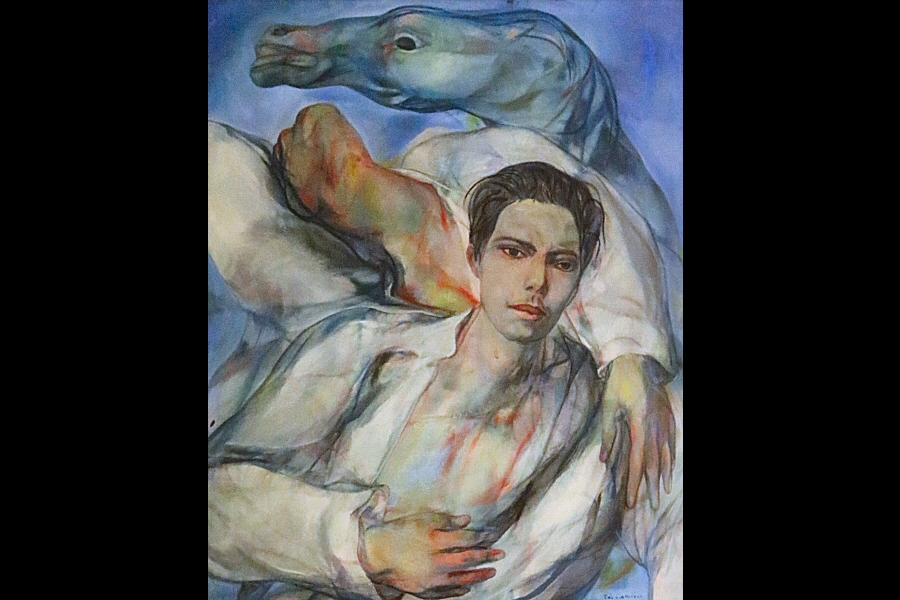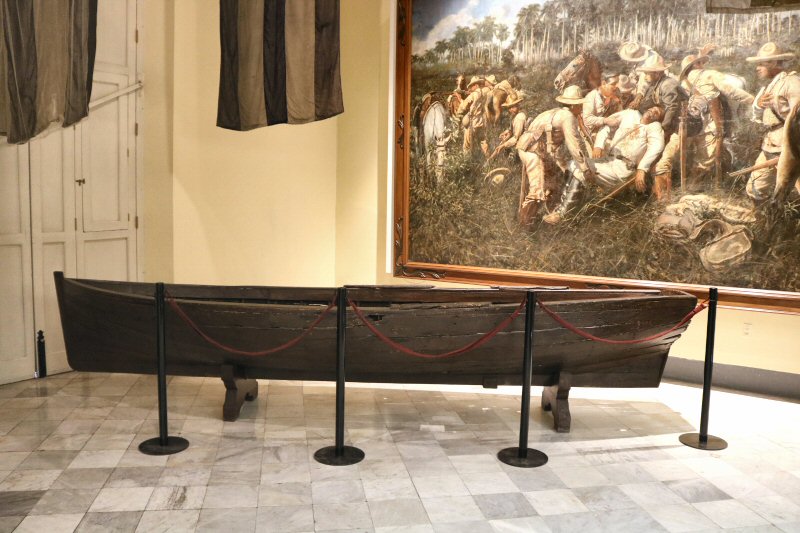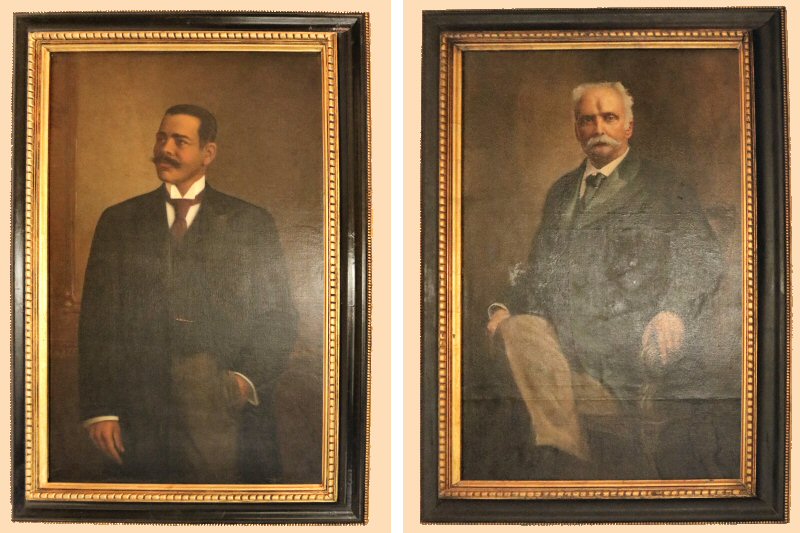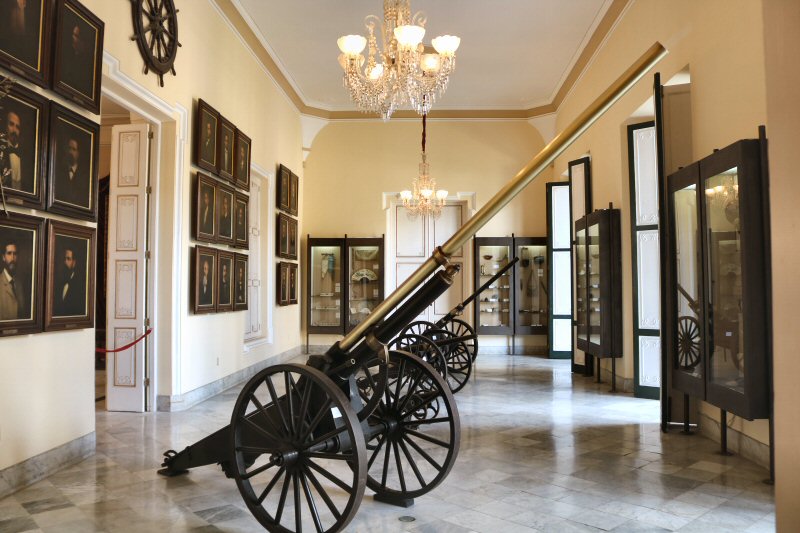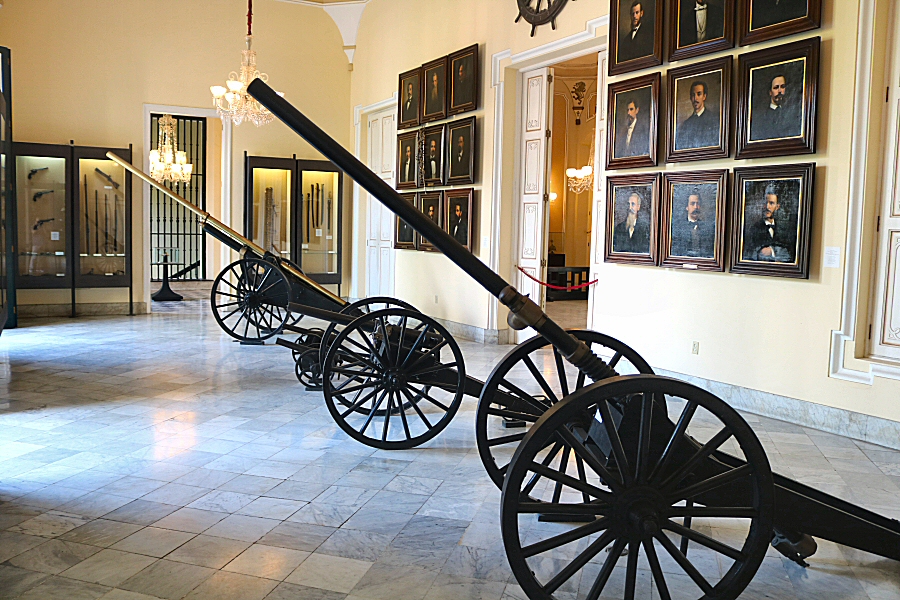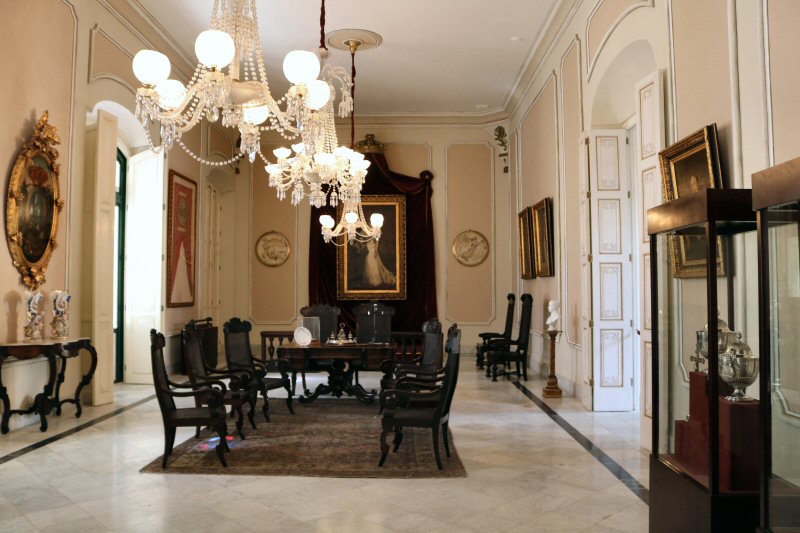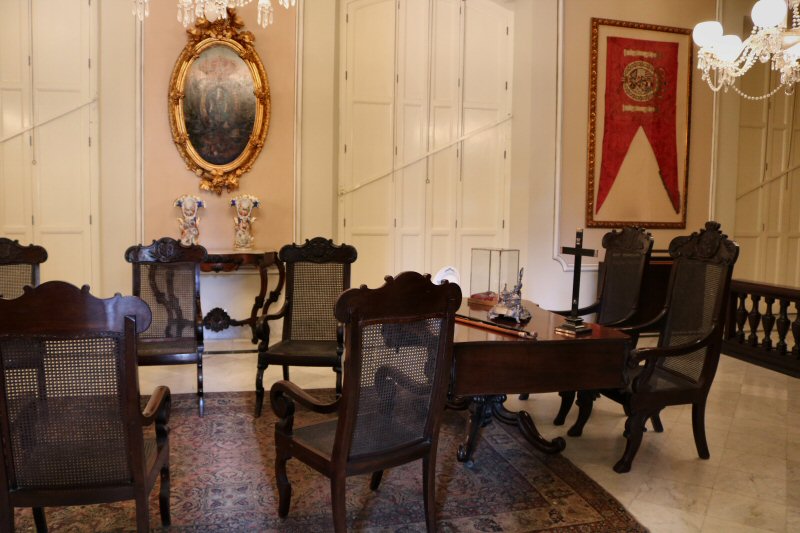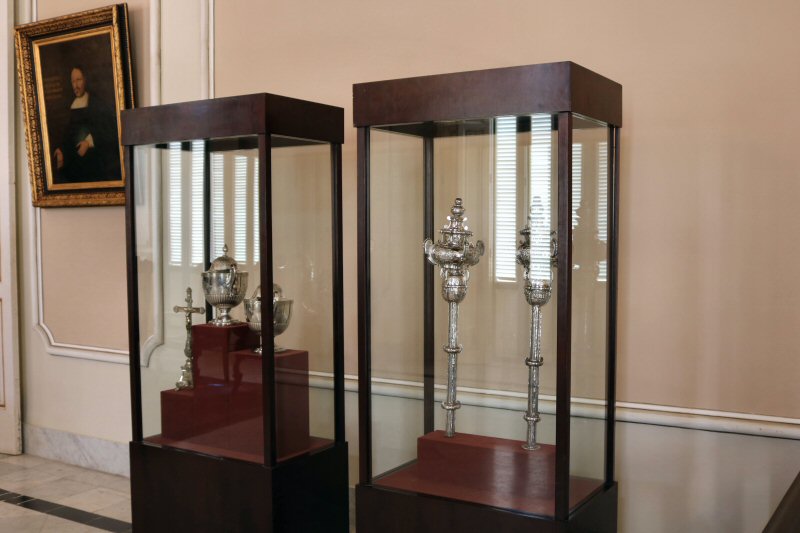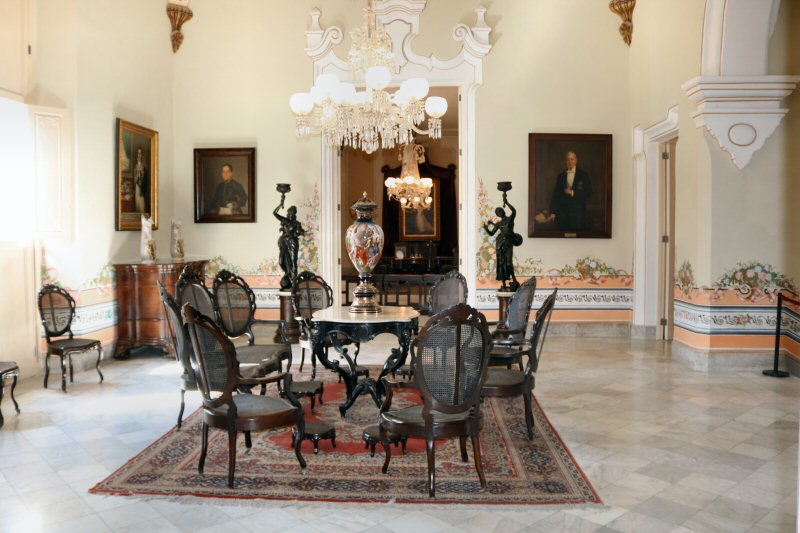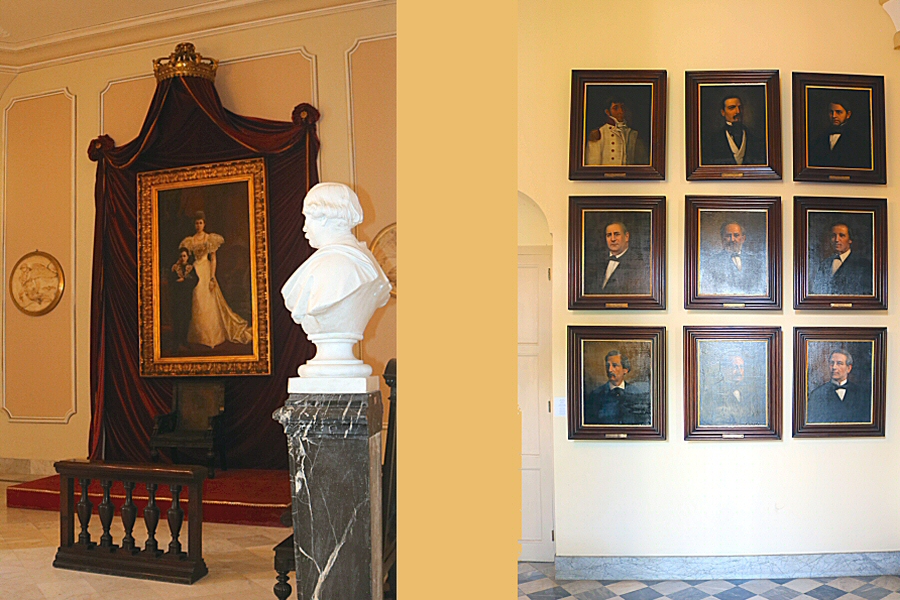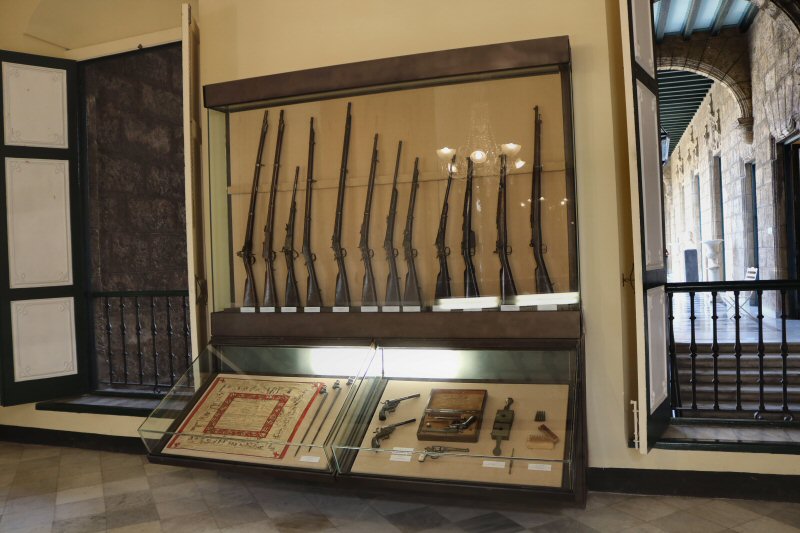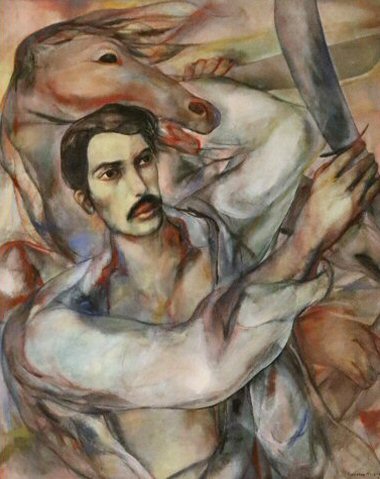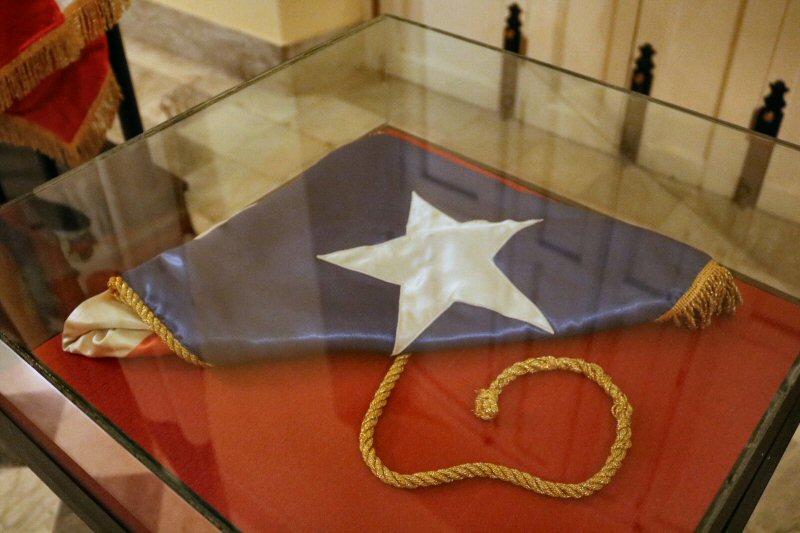
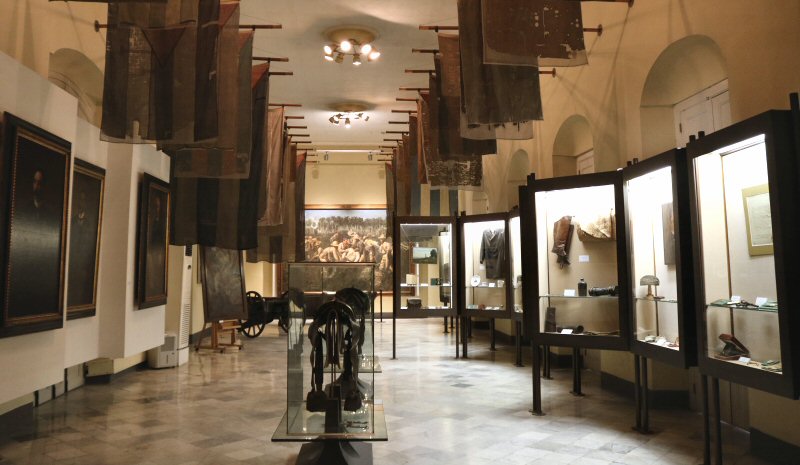
THE UPPER FLOOR - THE SOUTH PART
The most important room for the
visitors that have interest in the history of the struggle of independence of Cuba, is the Sala de Banderas (Room of the
Flags). In this hall some national treasures are exhibited, such
as the original flag waved for the first time in Cárdenas in
1850. In the Assembly of Guáimaro,
the first constitutional assembly, in 1869, it was declared as
the national flag of the Republic of Cuba in Arms.
The flag that the Major General Máximo Gómez used during the Ten
Years War, is also framed and exhibited in the hall. Towards the
end of the hall you will see many Cuban flags, used during
different periods, each having a different story. There is also
the flag of the Republic of Chile, sent to Cuba by the President
Dr. Salvador Allende.
The oil painting portraits of the most
known heroes of the struggle for independence, such as Carlos
Manuel de Céspedes, Calixto García Íñiguez, Ignacio Agramonte y
Loynaz, Antonio Maceo Grajales, José Julián Martí Pérez, Máximo
Gómez Báez etc. are brought together and hung side by side at
the wall (27 personalities). At the end of the hall you will see
also large-format portraits of Calixto García, Antonio Maceo
Grajales, José Martí and Máximo Gómez Báez.
Among the oil paintings in the hall the most remarkable one is La Muerte de Maceo, painted by the Cuban artist Armando García Menocal in 1908. It illustrates the fall of Antonio Maceo in the battle against the Spanish troops in San Pedro Arriba in September 12, 1899. There is another oil painting of Antonio Maceo: The Disembarkation of Maceo (1928) by Hugo de Soto (1984). Antonio Maceo is also represented riding on his horse by the Cuban painter Eduardo Urzais in 1897.
The oil painting of the Cuban artist Carlos
Enriquez Moreno, done in 1939, reflects another painful event,
the fall of José Martí in the battle against the Spanish in Dos
Rios in May 19, 1985. Another oil painting, done by Servando
Cabrera Moreno in 1976, belongs to the brave Juan Bruno Zayas,
one of the youngest generals of the war of independence that had
also a short life (1867-1896), illustrating him in the vanguard
during the battle. In another oil
painting by Servando Cabrera Moreno (1976), Panchito Gómez Toro
is represented during the fight. Panchito Gómez Toro is the son
of Major General Máximo Gómez and fell in combat with Antonio
Maceo, when he was just 20 years old..
The hall contains a lot of personal objects of the top leaders.
§ the court sword (Espadin
de Gala) and its scabbard, the gift of the New Yorker newspaper The Journal,
§ the small compass,
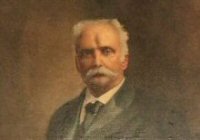
§
the walking stick made of bamboo rush and silver, given to Dr. Ramón Emeterio Betances, the Puerto Rican patriot and the member of the Cuban Revolutionary Party in Paris during the combat in 1895, by Antonio Maceo as gift,
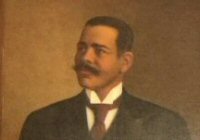
§ the revolver (Lefaucheux, made in France) with that he shot three times, when he met the troops in Yara in October 11, 1868,
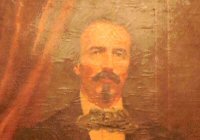
§ the uniform,
§ the silk bag for documents,
§ the primary edition of his book with the title Versos Sencillos (Simple Verses), printed in New York in 1891. He had signed it for her friend Irene,
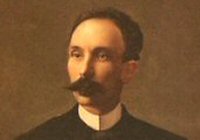
Additionally, the uniforms of Adolfo
del Castillo y Sánchez and Jose Maria Rodriguez, and the
personal objects of Francisco Gómez Toro, the son of Máximo
Gómez, are exhibited in showcases.
At the end of the hall a wooden boat
and a cannon are exhibited. The boat was used by Antonio Maceo
during his invasion to the west. He crossed the path from Mariel
to Majana by the help of this boat in March 15, 1896. The
cannon, Hatchkiss 70 mm caliber, made in USA, was used by
Calixto García Íñiguez during the battles in Loma de Hierro
(historical place, located in the vicinity of the town Floro
Pérez, Holguin; the artillery was used by the mambises for the
first time here), Las Tunas and Guáimaro. The cannon was
baptized with the name of Cayo Hueso (Key West) in homage to the
Cuban emigrants that bought it by their own.
In a show case the saddle and its
cloth, as well as the spurs, made of iron and silver, that
belonged to the Major General Antonio Maceo, are exhibited. They
were brought from the Army Museum of Madrid by exchange of
historical pieces.
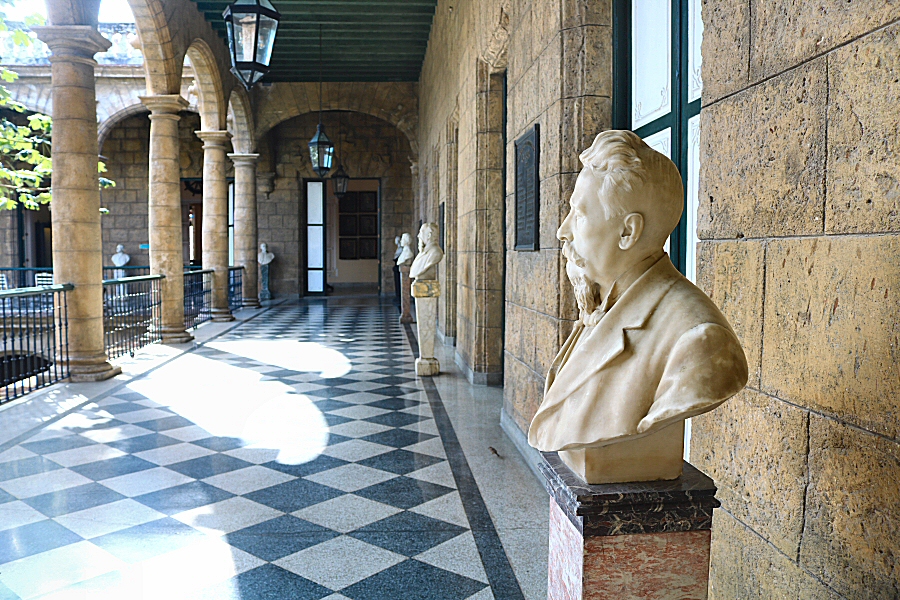 In the room Cuba Heroica (Heroic Cuba)
the walls are covered with the oil portraits of the Cuban
heroes, but the most striking pieces, exhibited in this room,
are the different size and different caliber artillery models.
The showcases are full of war materials, such as pistols,
rifles, bags, trumps, cannon balls etc. A handmade cannon (cañón
artesanal) that was produced by the Lieutenant Luis Martínez,
deserves to have a look. Black powder was used as explosive in this
cannon that could throw shrapnels and many other objects.
Several machetes, used by different personalities, are on
display. The machete that belonged to the Colonel Ernesto Fonts
Sterling was made of the saber of a Spanish
official that the Colonel had forgiven his life. The machete
with its scabbard belonged to the Brigadier General Juan Bruno Zayas Alfonso.
In the room Cuba Heroica (Heroic Cuba)
the walls are covered with the oil portraits of the Cuban
heroes, but the most striking pieces, exhibited in this room,
are the different size and different caliber artillery models.
The showcases are full of war materials, such as pistols,
rifles, bags, trumps, cannon balls etc. A handmade cannon (cañón
artesanal) that was produced by the Lieutenant Luis Martínez,
deserves to have a look. Black powder was used as explosive in this
cannon that could throw shrapnels and many other objects.
Several machetes, used by different personalities, are on
display. The machete that belonged to the Colonel Ernesto Fonts
Sterling was made of the saber of a Spanish
official that the Colonel had forgiven his life. The machete
with its scabbard belonged to the Brigadier General Juan Bruno Zayas Alfonso.
The Cabildo (City Hall) can be accessed
through the room Cuba Heroica, as well as through the Antesala
del Cabildo (Anteroom of Town Hall). Once the Palacio de los
Capitanes Generales was built, the important personalities of
the city that want to promote the socio-economic and cultural
development of the city, were moved to this Cabildo room. The
maces, made of silver, are the most ancient works of the
silversmiths in the city, shining in the showcases. The room
served also as a funeral chapel, in that it was held a wake over
Leonar Pérez, the mother of José Martí.
The Antesala del Cabildo
(Anteroom of the City Hall) can be
accessed from the mezzanine by a wide staircase. The shields of
the city of Havana and Cuba on the stained-glass windows that
lighten the staircase, are outstanding.
In Sala de Pensamiento Cubano (Thought
Room) the oil portraits of some outstanding characters of the
19th century Cuban thoughts, painted by the Cuban artist
Federico Martínez, are adorning the walls. The oil portrait of
the Spanish Queen Isabel II is hung on the wall.
In Sala de Armamento Español (Spanish
Armament Room) a small collection of various weapons and their
equipment, used by the Spanish forces in Cuba, are exhibited in
showcases. Miscellaneous weapons, from the primitive flintlock
rifle to the modern Mauser, bayonets, pistols, bullets, and a
military training handkerchief are the exhibited pieces in the
room.
